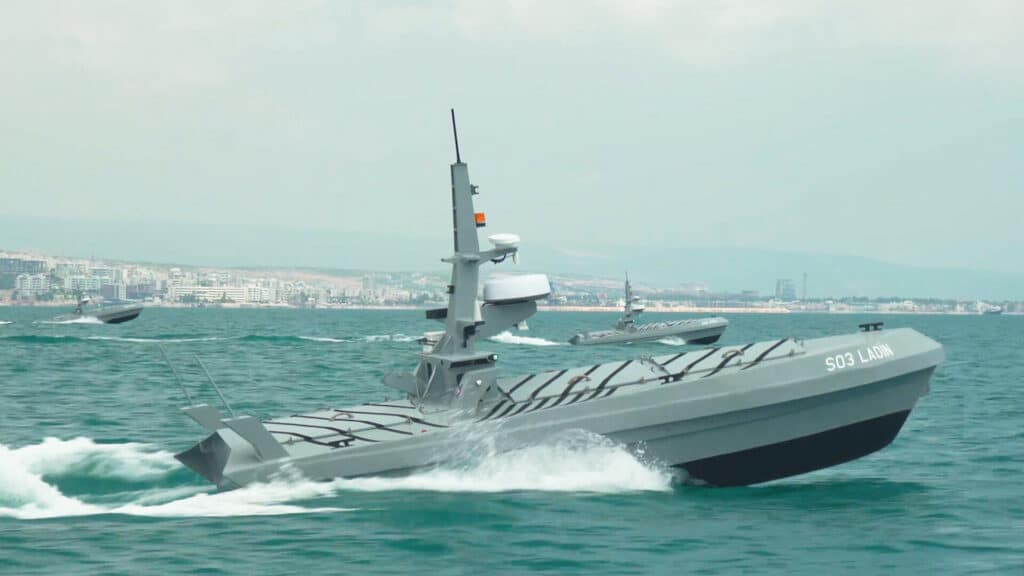The company first hinted at the project in October 2021 with a “coming soon” advertisement. Two months later, the USV 15 is introduced. Dearsan made no reference to a partner company in the announcement, while most Turkish USV projects involve collaborative partnerships.
The design phase of the brand-new vessel is complete, and while Dearsan did not provide a date, the vessel’s launch appears to be soon.
The prototype introduced on social media is dubbed “ATAK USV 15,” which indicates an attacking version of the USV armed with a stabilized gun system and a missile launcher. USV 15 is a vessel family name rather than a specific model. Dearsan revealed that the sea trials of the attack USV will be conducted soon.
“There will also be 3 different AUSV’s with different configurations in the Fleet; 15 m AUSV Surveillance and 11 m AUSV’s designed in 2 different versions. The first member of the AUSV family, “15 m Attack AUSV” which we will perform the sea trials very soon will be capable of carrying a 12.7 mm Stabilized Remote Controlled Weapon System and Guided Missile System and reach up to 60 knots as per the end-user requirements.”
Dearsan Shipyard
Dearsan also claimed that the AUSV could also be deployed on a naval vessel, can be remotely controlled by any kind of mobile vehicle, headquarters, command centers, and floating platforms. It will be a full autonomy vessel and serve in missions such as reconnaissance, surveillance and intelligence, surface warfare, asymmetric warfare, armed escort, and strategic facility security.
Specifications of the USV 15

The USV 15 is designed for a wide range of missions such as surface warfare, engagement with an asymmetric threat, coast guard tasks, SAR operations, and so on. The vessel has an open system architecture that allows it to be customized to meet the needs of the end-user. As a result, it has a combat system that can be configured to alter the firepower for varied conditions and missions.
The USV 15 is a composite-hulled boat with an overall length of 14.79m and a beam of 3.83m. The main power will come from two diesel engines capable of reaching speeds of more than 50 knots, with the company claiming that the top speed can be increased to 60 knots depending on user requirements. Two waterjets are installed on the vessel. At economical speed, the operational range will be 300 nautical miles.
The attack variant will be armed with a 12.7 mm Stabilized Remote Controlled Machine Gun and a Stabilized Turret Weapon System capable of launching Turkish Roketsan’s laser-guided Cirit and L-UMTAS missiles.

The USV 15 will be equipped with an Autonomous Management System, which will allow the vessel to navigate autonomously. It will be outfitted with an Electro-Optical Reconnaissance and Surveillance System, including CCTV and a thermal camera to provide 360-degree surveillance.
The communication system on the USV is made up of a SATCOM and a wideband transceiver (LOS).
Author’s comment:
The Turkish defense sector has made remarkable progress in developing USV capabilities after demonstrating its UAV capabilities in real-world operations. In comparison to UAVs, USV is a niche field. While numerous armed forces have a range of UCAVs in their inventory, there aren’t nearly as many operational-ready USVs.
In this regard, Turkish defence companies have been working on four (known) USV projects. The first project, ULAQ, which passed all tests and has been sea-proven, is now in mass production. Last month, the joint venture of ARES Shipyard and Meteksan Defence introduced the ULAQ to NATO countries, and it is regarded as a strong prospect to dominate this field. Another project announced by Turkey’s leading defense corporation Aselsan in July 2021 is the NB57 ASW and RD09 ASuW USVs. Sefine Shipyard, Aselsan’s project partner, cut the first steel for the vessels this summer.
Aside from these projects, Aselsan unveiled its USV Swarm concept, dubbed “Albatros-S,” during the IDEF-2021 defense show in Istanbul in August 2021. While Albatros-S is a technological development project, it is interoperable with other USV programs as well as Albatros-S unmanned surface vessels.
Dearsan’s USV 15 project stands out as the fourth in this category. Although the company did not provide any information about the customer, it is possible that the new USV has significant export prospects. Dearsan has constructed patrol boats and the C-92 corvette for the Turkmen Navy, and has recently announced an agreement to build two OPVs for the Nigerian Navy; the USV 15 would be Dearsan’s third export success.
ULAQ of Ares Shipyard & Meteksan RD09 of Aselsan & Sefine Shipyard Albatros-S of Aselsan USV 15 Fleet of Dearsan Shipyard










